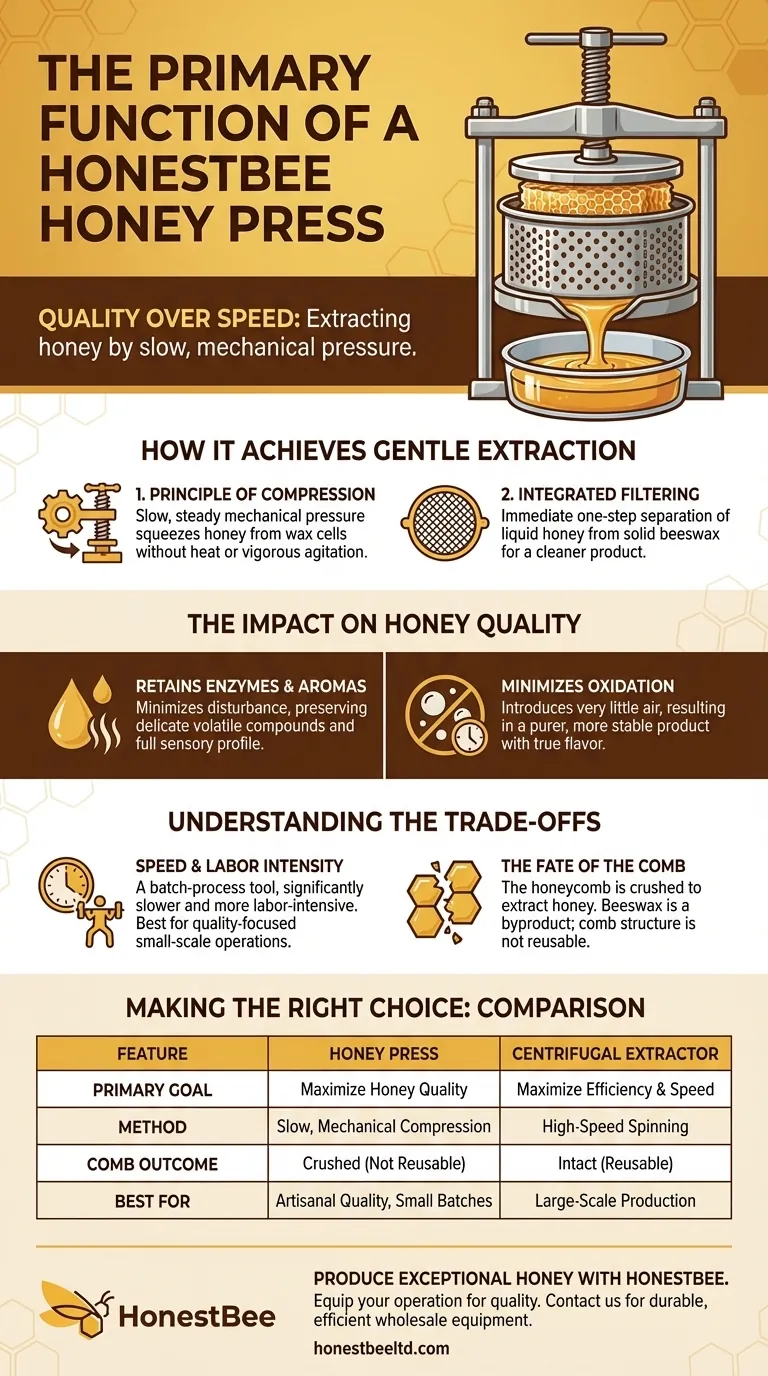At its core, the primary function of a Honey Press is to extract honey from the honeycomb. It uses slow, mechanical pressure to squeeze the honey from the uncapped comb, separating it from the beeswax in a process that prioritizes quality over speed.
The decision to use a honey press is a choice for quality. While other methods focus on speed, the press is designed for a gentle extraction that preserves the honey's most delicate aromas, flavors, and natural enzymes.

How a Honey Press Achieves Gentle Extraction
The value of a honey press is not just in what it does, but how it does it. The method is fundamentally different from high-speed centrifugal extractors.
The Principle of Compression
A honey press operates on the simple principle of mechanical compression. Uncapped honeycombs are placed inside the device, and a plate is slowly turned or pressed down.
This slow, steady pressure gently squeezes the honey out of the wax cells without introducing the heat or aeration associated with high-speed spinning.
Integrated Filtering
Most honey presses are designed with a perforated basket or a filtering mechanism at the base. As the honey is squeezed from the comb, it immediately passes through this filter.
This one-step process separates the liquid honey from the solid beeswax, resulting in a cleaner product right from the start.
The Impact on Honey Quality
The gentle compression method has a direct and positive impact on the final quality of the honey.
Retaining Natural Enzymes and Aromas
Vigorous agitation and aeration, common in centrifugal extraction, can degrade the delicate enzymes and volatile aromatic compounds that define a honey's unique character.
A honey press minimizes this disturbance, helping to retain the honey's full nutritional and sensory profile. It produces a product that is as close as possible to how it exists in the hive.
Minimizing Oxidation
When honey is whipped with air, it begins to oxidize, which can subtly alter its flavor and potentially shorten its shelf life. The slow, contained process of a press introduces very little air into the honey.
This results in a purer, more stable product with a flavor profile that remains true to its floral source.
Understanding the Trade-offs
While excellent for quality, a honey press is not the right tool for every situation. Understanding its limitations is key.
Speed and Labor Intensity
A honey press is a batch-process tool that is significantly slower and more labor-intensive than a centrifugal extractor. It is best suited for small-scale operations or hobbyists where quality is the paramount concern.
The Fate of the Comb
This is the most significant trade-off. A honey press crushes the honeycomb to extract the honey. The beeswax is a byproduct, but the comb structure is destroyed.
In contrast, centrifugal extractors are designed to keep the comb intact, allowing beekeepers to return the empty frames to the hive. Bees can then refill them immediately, saving the significant energy required to build new wax comb.
Making the Right Choice for Your Goal
Your extraction method should align directly with your beekeeping philosophy and operational goals.
- If your primary focus is maximum quality and purity: The honey press is the superior choice for creating artisanal honey that preserves delicate flavors.
- If your primary focus is efficiency and reusing combs: A centrifugal extractor is better for larger operations where speed and comb preservation are critical for honey production volume.
- If you are a hobbyist producing small batches: A honey press offers an excellent, straightforward method for achieving exceptional quality without the complexity of larger equipment.
Choosing the right tool is about understanding the balance between preserving the comb and preserving the honey itself.
Summary Table:
| Feature | Honey Press | Centrifugal Extractor |
|---|---|---|
| Primary Goal | Maximize Honey Quality | Maximize Efficiency & Speed |
| Method | Slow, Mechanical Compression | High-Speed Spinning |
| Comb Outcome | Crushed (Not Reusable) | Intact (Reusable) |
| Best For | Artisanal Quality, Small Batches | Large-Scale Production |
Produce Exceptional Honey with the Right Equipment
For commercial apiaries and distributors focused on quality, the right extraction method is key. HONESTBEE supplies durable, efficient honey presses and a full range of beekeeping supplies designed for professional results.
Let us help you equip your operation for success. Contact HONESTBEE today to discuss your wholesale equipment needs and preserve the purity of your honey.
Visual Guide

Related Products
- Electric Honey Press Machine for Squeezing Honey Comb Press Equipment
- Easy Use Manual Stainless Steel Honey Press for Honey Comb
- 10L Stainless Steel Electric Honey Press Machine
- Stainless Steel Manual Honey Press with Guard for Pressing Honey and Wax
- HONESTBEE 3-Frame Manual Acrylic Honey Extractor
People Also Ask
- How does a honey press work? A Guide to Simple, High-Yield Honey Extraction
- How does using a honey press affect honeycomb reuse? It Destroys Comb but Captures Unique Honey & Wax
- How should a honey press be cleaned? A Step-by-Step Guide for Beekeepers
- Why are honey presses particularly useful for beekeepers using Top Bar hives? Maximize Your Harvest
- What are the reasons for choosing a honey press over a dedicated honey extractor? Maximize Disease Control and Natural Beekeeping



















